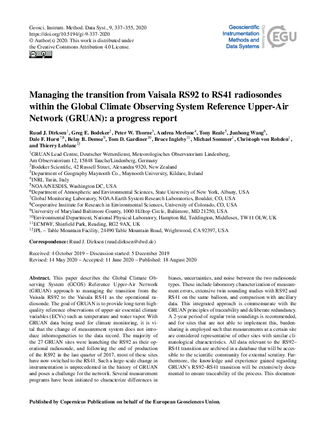This paper describes the Global Climate Observing System (GCOS) Reference Upper-Air Network (GRUAN) approach to managing the transition from the Vaisala RS92 to the Vaisala RS41 as the operational radiosonde. The goal of GRUAN is to provide long-term high-quality reference observations of upper-air essential climate variables (ECVs) such as temperature and water vapor. With GRUAN data being used for climate monitoring, it is vital that the change of measurement system does not introduce inhomogeneities to the data record. The majority of the 27 GRUAN sites were launching the RS92 as their operational radiosonde, and following the end of production of the RS92 in the last quarter of 2017, most of these sites have now switched to the RS41. Such a large-scale change in instrumentation is unprecedented in the history of GRUAN and poses a challenge for the network. Several measurement programs have been initiated to characterize differences in biases, uncertainties, and noise between the two radiosonde types. These include laboratory characterization of measurement errors, extensive twin sounding studies with RS92 and RS41 on the same balloon, and comparison with ancillary data. This integrated approach is commensurate with the GRUAN principles of traceability and deliberate redundancy. A 2-year period of regular twin soundings is recommended, and for sites that are not able to implement this, burden-sharing is employed such that measurements at a certain site are considered representative of other sites with similar climatological characteristics. All data relevant to the RS92–RS41 transition are archived in a database that will be accessible to the scientific community for external scrutiny. Furthermore, the knowledge and experience gained regarding GRUAN's RS92–RS41 transition will be extensively documented to ensure traceability of the process. This documentation will benefit other networks in managing changes in their operational radiosonde systems.
Preliminary analysis of the laboratory experiments indicates that the manufacturer's calibration of the RS41 temperature and humidity sensors is more accurate than for the RS92, with uncertainties of <0.2 K for the temperature and <1.5 % RH (RH: relative humidity) for the humidity sensor. A first analysis of 224 RS92–RS41 twin soundings at Lindenberg Observatory shows nighttime temperature differences <0.1 K between the Vaisala-processed temperature data for the RS41 (TRS41) and the GRUAN data product for the RS92 (TRS92-GDP.2). However, daytime temperature differences in the stratosphere increase steadily with altitude, with TRS92-GDP.2 up to 0.6 K higher than TRS41 at 35 km. RHRS41 values are up to 8 % higher, which is consistent with the analysis of satellite–radiosonde collocations.

